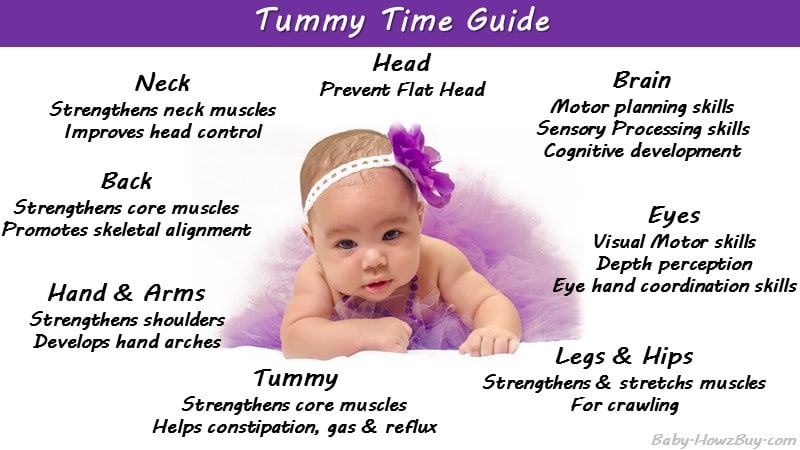Being a pediatric PT, I get asked all the time “how can I make tummy time for my child more enjoyable? All they ever do is cry in the position!” The answer is scarily simple but for most parents who have either never had a child or had an easy going baby who liked tummy time to start off with they might not be able to come up with answer on their own. The answer, of course, is PLAY. Tummy time is no fun if you are down there by yourself struggling to hold your head up and no one is playing with you or helping you engage in the environment! This blog post dives into why kids aren’t getting enough tummy time anymore and the implications of that; how to improve and make sure your baby gets enough quality tummy time; how much tummy time is appropriate, what are some of the awesome benefits of enough tummy time and so much more!
Tummy time is so fun!
The Safe to Sleep (Back to Sleep) and Tummy Time for Play Relationship
As many of you know, the Safe to Sleep (formerly Back to Sleep) Campaign has reduced the incidence of SIDS by 50% since its institution in 1994 by the American Academy of Pediatrics. However, many studies have shown that there is also an associated decline in gross motor function, social, and overall development at 6 months of age in infants who supine (back) sleep. Further follow up studies to these original studies showed that the decline in motor skills was more correlated to a lack of prone (tummy) time spent while awake and alert. When the Safe to Sleep campaign started, the pendulum ultimately swung very far toward the “scared to place my child on their tummy for fear of SIDS direction.” This prompted a change in language and new recommendations by the American Academy of Pediatrics encouraging parents to make sure their babies got enough prone time while awake to mitigate the delays in gross motor development from supine sleeping. The AAP encourages increasing tummy time to play while alert and supervised by an adult and also educating that prone time spent during play will not have negative consequences on your baby while they sleep (actually might positively impact their sleep but more on that later in the blog!)
Hmm…wonder how I can get more tummy time??
My kid hates tummy time…do I really have to make them do it?
So your kiddo hates tummy time eh? Scream bloody murder the moment you put them down? Feel like a horrible parent for making them cry so hard? Well don’t! Babies hate tummy time because it is hard and crying is their only way of protest. And tummy time is hard because they don’t practice it enough to get strong enough for it to be easy! Heads are VERY heavy compared to their small baby muscles and gravity is mean and unrelenting. So you as the parent have to find ways to make tummy time just easy enough that they don’t hate it for long enough to get them stronger so that they can do tummy time as normally as possible… in a few short words, “Suck it up, buttercup, put your kid in tummy time!”
Of course, I hear your retort… “But why do I really have to ? Is it that bad for them?” The answer is YES, yes you do! and Here are some reasons why NOT having tummy time is BAD
Cranial Deformities: Medically known as plagiocephaly or brachiocephaly. There has been a dramatic spike in these types of conditions since the implementation of the Safe to Sleep Campaign. Increasing the amount of time spent on their belly helps to reduce the risk of deformation from supine lying over time in cribs or carriers.
Gross Motor Delay: There are 4 developmental positions that are assessed for an infant’s development: Supine (back), prone (tummy), sitting, and standing. If tummy time is developmentally missed (a crucial developmental position), a child will end up developmentally missing or delayed on many motor skills including locomotion. Some of these kiddos decide to never crawl…
Why crawling matters: There has been research and some known correlations between hand writing/reading proficiency, fine motor skills, hand/eye coordination, bi-manual coordination and whether or not a child crawled prior to walking. Crawling which is a progression of prone into quadruped (hands and knees) position and works on integration between upper limbs, vision/perception, and dissociation between the LE’s in preparation for walking. Therefore if tummy time is missed, likely a child will be delayed in crawling, which may potentially lead to decreased proficiency in many other areas of development as they age.
Alright so there are some of the negatives to not doing tummy time… But what about the positives? Why is tummy time good?? The infographic below has some great summary information on all the benefits! But below that you’ll find some of my elaborations on a few of the key points.
This infographic is a perfect summation of all the benefits of Tummy Time for Play.
By Rmpathak73 - {{Tummy Time Guide Infographics}}, CC BY-SA 4.0, https://commons.wikimedia.org/w/index.php?curid=71229367
Explained…
Strengthening: As your baby works against gravity they are working all of the head, neck, trunk/core, and hip muscles to keep their head up and looking at the world. Gravity is your babies biggest work out motivator and biggest rival when it comes to learning to control their own bodies. The more time they spend on their tummy working against gravity the faster they’ll become stronger and more capable of controlling themselves in space.
Fine motor skill development: As your baby works on pressing up, shifting side to side, and reaching, they are laying down the foundations of skills to work on fine motor and grasping skills.
Sensory Processing: Because of the intense amount of body/skin contact with whatever surface they are laying on a baby gets a large amount of sensory input about their position in space as well as tactile information from the surface they are on. This information then goes back to the brain to help them learn how to process tactile input more effectively as well as help them develop an increasing more clear body image of themselves and proprioceptive sense (position of body in space).
Hand Eye coordination: Because their hands are directly in front of their developing eyes in this position a baby learns more about where and how to move their hands to benefit them while in this position- whether it be reaching for a toy or figuring out how to roll themselves out of the position!
***New Research also suggests that babies SLEEP BETTER when they get an appropriate amount of tummy time a day! There are also some other interesting ties to weight and childhood obesity that you can read about in this article.
Tummy Time can do all that??
Photo by Silvia Trigo from Pexels
How much tummy time is enough tummy time??
Depending on the age of your baby, the recommendations for tummy time change. But as a rule of thumb, the older they are the more time they should be spending on their bellies and the more they should want to be there! Our goal is to get enough tummy time to mitigate the negative consequences of back sleeping on their development- and turns out it isn’t THAT much time needed to really help them along!
0-3 months:
Yep that’s right! You can start tummy time the moment that baby gets here! I know a concern that parents may have is damage to the umbilical cord/area, but that is just a wives’ tale! It is perfectly safe and highly encouraged to start your baby even in their first couple days of life with some form of tummy time. Whether that be skin to skin on your chest in a reclined position or as they get a little older over your lap or boppy pillow.
Up to three months old, as a parent you should be aiming for 30 min to 1 hour of accrued, QUALITY tummy time a day (building up from day one so that by three months they can roughly get 1 hour). That means 5 minutes here and 3 there… and another 10 when they were happy and awake and lifting their head up even briefly (thats the quality part)! If your baby just happens to lay their head down and rest in this position, it does not count as active quality tummy time and should not be counted in the overall amount.
4-6 months
At this stage, your baby is getting pretty good at tummy time and starting to roll, reach for objects, and hold themselves easily there. They can interact with their world without a lot of effort but still may need some modifications to make tummy time interesting/enjoyable. That includes lots of cool toys to hold their interest or having a parent down on the floor playing along.
1-2 hours of accrued tummy time a day is your goal by 6 months of age! With either tummy time or sitting positions being the preferred position of play for babies at 6+ months of age. A typically developing baby who is that age and still preferring back play desperately needs other positions encouraged because they are coming to a period in brain development where self-environmental exploration is key.
6+ months:
Your baby will soon be learning how to get into and out of all of their development positions and we should see them begin to spend more time in a quadruped position as an advancement of the tummy time for play and begin working toward crawling activities.
You should be allowing independent play for at least 2+ hours a day so your baby can practice movements and self-environmental exploration in order to promote development of new skills. Make sure you have plenty of toys to help engage them in exploration of their environment. See my toy blog for ideas on appropriate toys for this age!
I can see your eyeballs growing bigger now! How can I get my baby to do all that tummy time you say…well keep reading! Its easier than you think!
Tummy Time comes in many different shapes and sizes
Luckily tummy time is easily modified to increase your baby’s tolerance of the position while still getting the benefits of being prone!
Laying on your Chest/over your shoulder
Best for 0-3 month olds
Lay your baby in a reclined position either over your shoulder or on your chest.
Chest: easy way to engage with your infant to make tummy time fun! They can see your face fairly easily and will be encouraged to lift their head.
Shoulder: for the kiddo who LOVES to look at the world and will keep their head lifted to see what is going on
Over your lap or over a large ball (if you have one)
Best for 2-4 month olds
In a sitting position with both of your legs together, lay your baby over your lap so their arms are off the side and on the chair/surface you are sitting on or propped on your leg.
If using a ball, lay your baby on the ball and roll them forward and backward until you find the position where they can successfully lift their head up to see the world in front of them. The ball will help you decrease the amount of gravity pulling on them thereby making the position easier.
Make sure there are toys to engage with or another child/adult helping you with these versions to make them fun and enjoyable!
Supermans
Best for 3+ month olds who have good head control in tummy time
First way: Holding your baby around their middle or placing them on your lower legs, “fly” them over your head
Second way: carrying them in your arms on their belly and flying like an “airplane”
Make sure they are lifting their head and feet against gravity!
Propped on Boppy Pillow
Good for 3+ months old
Alternatively: over your leg or towel roll
If you don’t already own a boppy pillow, I highly recommend purchasing one. It will help significantly with tummy time immediately as well as sitting posture around 5-6 months.
Place your baby on their belly with their chest on the boppy pillow and arms over the pillow and placed in front of them. Place toys that your child finds interesting or get down to their level and play with them in this position.
Placing your child on their belly with the pillow increases their success of lifting their head by shifting weight from their shoulders back to their hips.
Placing them over your leg leg also has the same effect. The higher up your leg you place your child the easier it is for them because your thigh offers more support than your lower leg because of the height difference.
Alright so now you see how easy tummy time be! As well as how it important it is to get your baby in the position and some of the negatives of not performing this activity. Tummy time can be a great bonding activity instead of one of dread as long as you work on it appropriately with your baby! Help them be successful so they can reach all their milestone and develop to the best of their ability!








